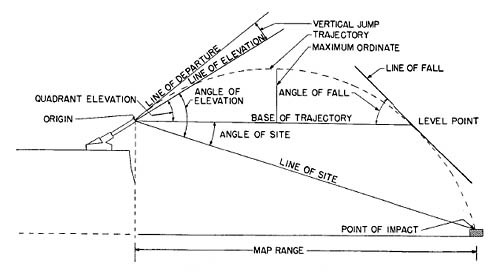Definition of elements of trajectory from FM 4-10: Coast Artillery Gunnery, War Department Field Manual, May 1944.
Elements of Trajectory
- 6. GENERAL. The trajectory is the path of the projectile from the muzzle of the gun to the first point of impact. The phrase, elements of the trajectory, is applied to the various features of the trajectory. (See figure.) The elements most frequently referred to are defined in the following paragraphs.
- 7. INTRINSIC ELEMENTS.
- a. Trajectory. The curve described by the center of gravity of the projectile in flight.
b. Ascending branch. That portion of the trajectory described by the projectile while rising.
c. Descending branch. That portion of the trajectory described by the projectile while falling.
d. Origin. The center of the muzzle of the piece at the instant of departure.
e. Summit. The highest point on the trajectory.
f. Level point. The point on the descending branch of the trajectory at the same altitude as the origin.
g. Base of the trajectory. The straight line between the origin and the level point.
h. Maximum ordinate. Difference in altitude between the origin and the summit.
- 8. INITIAL ELEMENTS.
- a. Line of elevation. The prolongation of the axis of the bore when the piece is set.
b. Line of departure. The prolongation of the axis of the bore as the projectile leaves the muzzle of the gun. It is tangent to the trajectory at its origin.
c. Line of site. The straight line between the origin of the trajectory and the target.
d. Plane of fire. The vertical plane containing the line of elevation.
e. Plane of departure. The vertical plane containing the line of departure.
f. Angle of elevation or elevation. The angle between the line of site and the line of elevation.
g. Angle of departure. The angle between the line of site and the line of departure.
h. Angle of site (ε). The angle between the line of site and the base of the trajectory.
i. Quadrant angle of elevation (φ) or quadrant elevation. The angle between the horizontal and the line of elevation.
j. Quadrant angle of departure (φ’). The angle between the horizontal and the line of departure.
k. Lateral jump. The horizontal angle between the plane of fire and the plane of departure.
l. Vertical jump. The difference between the angle of elevation and the angle of departure. It is positive if the angle of departure is greater than the angle of elevation.
- 9. TERMINAL ELEMENTS.
- a. Point of impact. The point where the projectile first strikes an object.
b. Line of fall. The line tangent to the trajectory at the level point.
c. Angle of fall (ω). The angle between the line of fall and the base of the trajectory.
- 10. OTHER ELEMENTS.
- a. Muzzle velocity (MV or V). Muzzle velocity or initial velocity is the velocity with which the projectile is assumed to leave the muzzle of the gun. It is the velocity of the projectile, measured at a distance from the muzzle, corrected for the theoretical loss in velocity during the travel from the origin of the trajectory to the point of measurement, considering that during that travel the projectile has been acted upon only by air resistance and gravity.
b. Remaining velocity. The remaining velocity at any point of the trajectory is the actual velocity at that point.
c. Terminal velocity (Vω). The remaining velocity at the level point.
d. Time of flight (t). The elapsed time from the instant the projectile leaves the muzzle to the instant of impact or to the instant of burst.
e. Range. The horizontal distance between two points, such as from the gun or directing point of a battery to the target.
f. Drift. The divergence of a projectile, due to its rotation and the resistance of air, from the plane of departure. It is usually expressed in angular units.











My cousin recommended this blog and she was totally right keep up the fantastic work!
It’s hard to come by decent info on the web now – thanks for this.